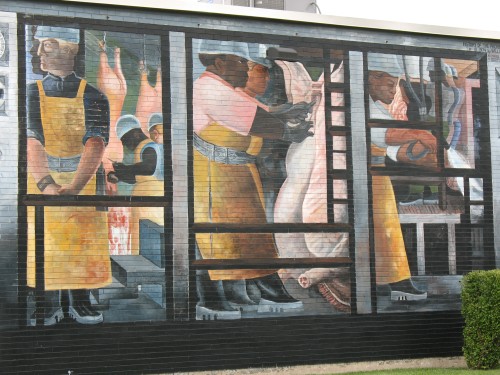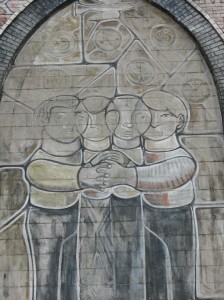As I’ve been hunting murals around Chicago, I’ve become really interested in how the community mural movement here got started. Community muralism is different from other movements (such as Mexican muralism and the WPA mural work) because it typically isn’t sponsored by the government. Instead, the artist and the community work together to create art that is “owned” by the community. Neighborhood residents often participate in selecting themes and actually painting the pieces. Community muralism arose from the social movements of the 1960s and sought to bring art out of the museums and onto the streets.
I associate community muralism with the Mexican American artists who work in Pilsen and Little Village. But to my surprise, it turns out that the community mural movement in Chicago — and the entire US — can be traced back to African American artists in Chicago’s Bronzeville neighborhood.
In 1967, members of the Visual Arts Workshop of the Organization for Black American Culture began to paint on a dilapidated building at 43rd and Langely. The building was slated for demolition as part of an urban renewal project, but the 21 artists transformed it into The Wall of Respect. The Wall featured 50 portraits of notable African Americans. “The Wall was created to Honor our Black Heroes, and to Beautify our Community,” read the inscription. William Walker was the only artist with formal training, and he emerged as a leader of the project.
The Wall quickly became a landmark — it was a rallying point for neighborhood residents, and it drew visitors from across the country. Artists began to create similar walls in other communities. As a result, the Wall became an obstacle for city government’s urban renewal plans. In 1969 and 1970 mass rallies forced the city to delay the scheduled demolition of the building. Finally, in 1971, a fire of “unknown origin” burned the building to the ground. Fortunately, the Block Museum at Northwestern University offers an incredible interactive website that re-creates the Wall online.
In 1970 Walker and John Weber founded the Chicago Mural Group, joining with Mexican muralists and other artists to form a multiracial artists’ cooperative. The group continues today as the Chicago Public Art Group (CPAG). Walker is now in his 80s and still lives in Bronzeville. Recently I set out with my friend M to look for the three Walker murals I had heard still existed. And we ended up finding four!
Walker painted History of the Packinghouse Worker in 1974 on the side of a union office at 49th and Wabash in Bronzeville. The building is now owned by the Chicago Housing Authority, and they commissioned a beautiful restoration by CPAG in 1998.

On the left side, workers confront their bosses atop a chessboard:


The right side features images of men at work in the packing house:

The piece reflects Diego Rivera’s work in both its style and subject matter. In a 2005 Chicago Reader article, mural historian Jim Prigoff commented, “I consider Bill Walker the Diego Rivera of the United States.” Viewing this mural, I can certainly see why.










